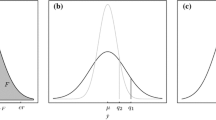Abstract
Water chemistry and properties vary within the boundaries of each quality (pollution) class; its rating within a class is best expressed in the domain of nominal values in the appropriate interval and worse expressed near its boundaries. Methods for evaluating such inconstancy were proposed under models of Taguchi (within an allowable interval) and Harrington (in a wider domain). This is shown to enable the assessment of acceptable and maximal admissible risks of the loss of water compliance with a specified quality class for making justified water-management decisions. A method of point estimate is proposed to simplify the expert characteristic of such risks, its application being of greatest use in multidimensional estimation problems.
Similar content being viewed by others
References
Aleksandrovskaya, L.N., Afanas’ev, A.P., and Lisov, A.A., Sovremennye metody obespecheniya bezopasnosti slozhnykh tekhnicheskikh sistem: Uchebnik (Present-Day Methods of Safety Control of Complex Technical Systems: A Textbook), Moscow: Logos, 2001.
Baranov, V.V., Protsessy prinyatiya upravlyayushchikh reshenii, motivirovannykh interesami (Processes of Making Managerial Decisions Motivated by Interests), Moscow: FIZMATLIT, 2005.
GOST (State Standard) R 50779.43-99: Statistical Methods. Acceptance Control Maps, 1999.
Danilov-Danil’yan, V.I., World Water Resources and the Perspectives of the Water Management Complex of Russia. http://www.sustainabledevelopment.ru.
Karandashov, K.K., Dopuski i posadki v mashinostroenii (Clearance Allowances and Fits in Mechanic Engineering), Tomsk: Tomsk Gos. Arkh. Str. Univ., 2006.
RD 52.24.643-2002. Metod kompleksnoi otsenki stepeni zagryaznennosti poverkhnostnykh vod po gidrokhimicheskim pokazatelyam (Method for Integrated Assessment of Surface Water Pollution by Hydrochemical Characteristics), 2002
SanPiN 2.1.4.1116-02. Pit’evaya voda. Gigienicheskie trebovaniya k kachestvu vody, rasfasovannoi v emkosti (Sanitary Standards and Regulations 2.1.4.1116-02. Drinking Water. Hygienic Requirements to the Quality of Bottled Water).
Frumin, G.T. and Barkan, L.V., Complex assessment of water pollution in Lake Ladoga according to hydrochemical indices, Water Resour., 1997, vol. 24, no. 3, pp. 289–293.
Shabanov, V.V. and Markin, V.N., Metodika ekologovodokhozyaistvennoi otsenki vodnykh ob”ektov. Monografiya (Method of Ecological–Water-Management Assessment of Water Bodies), Moscow: Mosk. Gos. Univ. Pishch. Proizv., 2009.
Shitikov, V.K., Rozenberg, G.S., and Zinchenko, T.D., Kolichestvennaya gidroekologiya: metody sistemnoi identifikatsii (Quantitative Hydroecology: System Identification Methods), Tolyatti: Inst. Ekol. Vol. Bas. Ross. Akad. Nauk, 2001.
Bikbulatov, E.S. and Stepanova, I.E., Harrington’s desirability function for natural water quality assessment, Russ. J. General Chem., 2011, vol. 81, no. 13, pp. 2694–2704.
Chambers, D., Moran, R., and Trasky, L., Bristol Bay’s Wild Salmon Ecosystems and the Pebble Mine, Ch. 5, Portland, OR: Wild Salmon Center and Trout Unlimited, 2012. http://www.wildsalmoncenter.org/pdf/PM-Ch5.pdf.
Chowdhury, R.M., Muntasir, S.Y., and Hossain, M.M., Water quality index of water bodies along Faridpur-Barisal road in Bangladesh, Glob. Eng. Tech. Rev., 2012, vol. 2, no. 3, pp. 1–8.
Gallagher W., Operational Definition of Acids and Bases. In Chem 352. University of Wisconsin-Eau Claire, 2011. http://www.chem.uwec.edu/chem352_ s11/pages/elaborations/acids-bases/a_operational.html.
Holmes-Farley, R., Low pH: Causes and Cures, Reef Alchemy: Reefkeeping Magazine, 2004. http://www. reefkeeping.com/issues/2004-09/rhf.
IEC 60812:2006. Analysis techniques for system reliability— Procedure for failure mode and effects analysis.
Mandal, K.H., Influence of wastewater pH on turbidity, Int. J. Environ. Res. Dev., 2014, vol. 4, no. 2, pp. 105–114.
Smith, V.K. and William, H., Measuring Water Quality Benefits, Boston: Kluwer-Nijhoff Publishing, 2010.
Taguchi, G. and Chowdhury, S., Taguchi’s Quality Engineering Handbook, 2004.
Tyagi, S., Sharma, B., Singh, P., and Dobhal, R., Water quality assessment in terms of water quality index, Am. J. Water Resour, 2013, vol. 1, no. 3, pp. 34–38.
Voitenko, L., Kopilevich, V., and Strokal, M., The conception of water quality assessment used Harrington’s desirability function for different kinds of water consumption, Biores. Prirodokorist., 2015, vol. 7, nos. 1−2, pp. 25–36.
Author information
Authors and Affiliations
Corresponding author
Additional information
Original Russian Text © O.M. Rozental’, L.N. Aleksandrovskaya, 2018, published in Vodnye Resursy, 2018, Vol. 45, No. 3.
Rights and permissions
About this article
Cite this article
Rozental’, O.M., Aleksandrovskaya, L.N. Assessing the Degree of Water Compliance with Standards. Water Resour 45, 379–387 (2018). https://doi.org/10.1134/S0097807818030132
Received:
Accepted:
Published:
Issue Date:
DOI: https://doi.org/10.1134/S0097807818030132




